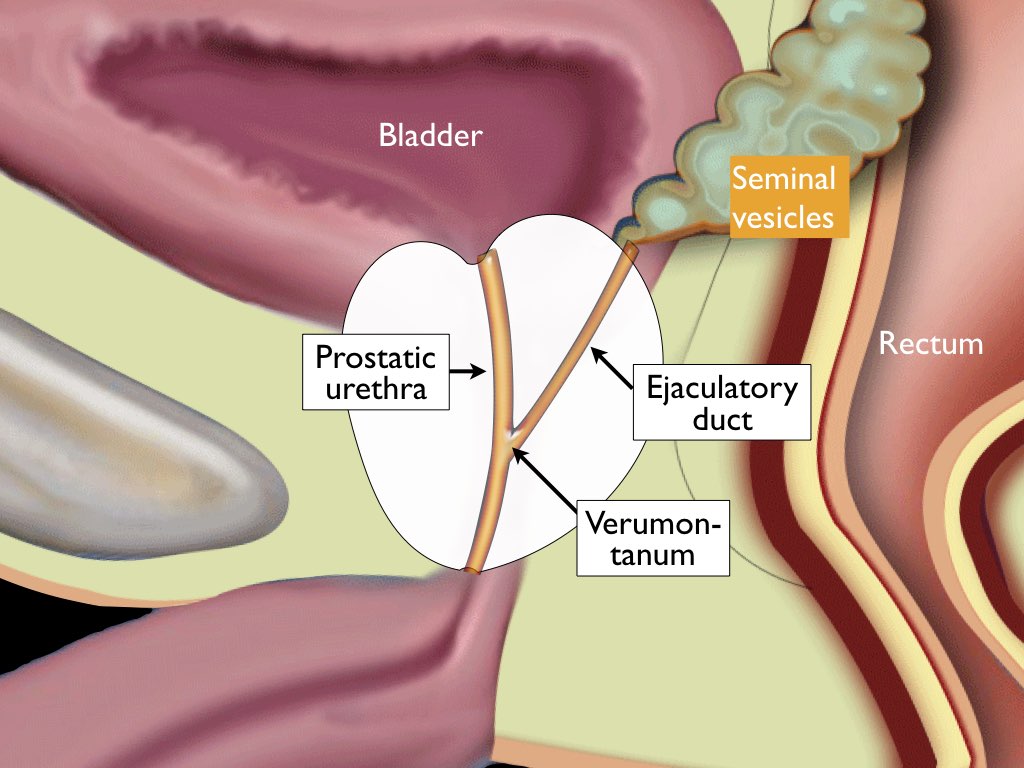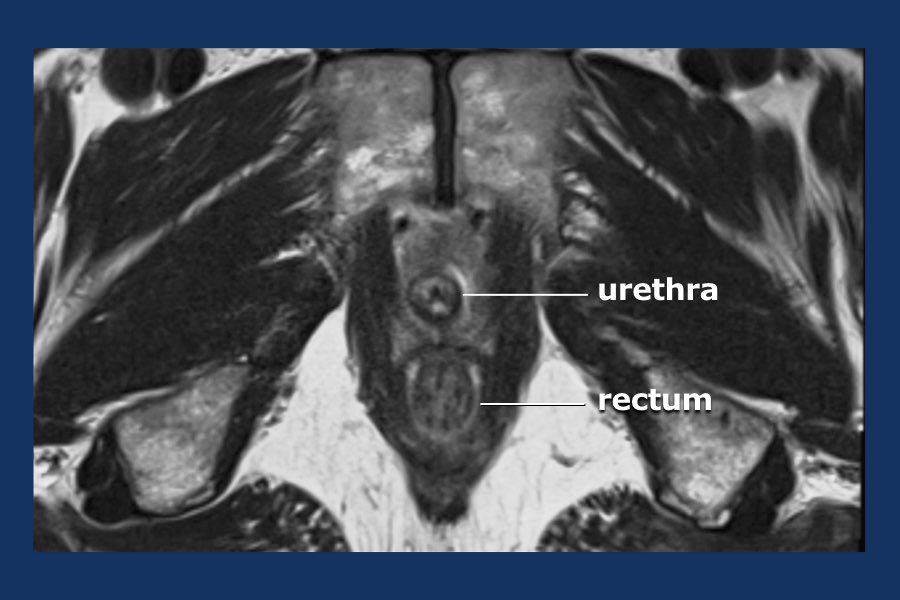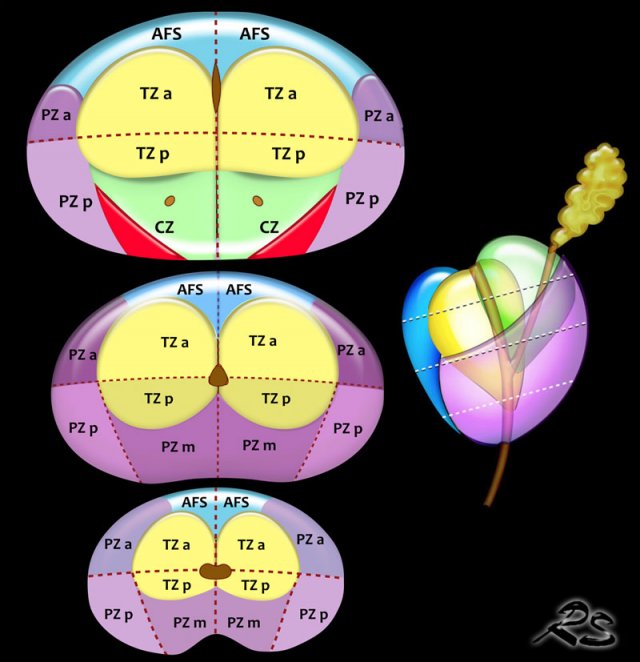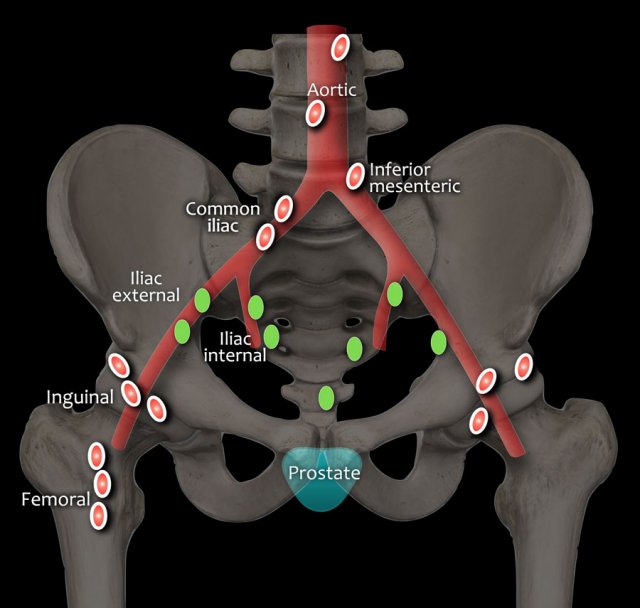Prostate Anatomy
Rhiannon van Loenhout, Frank Zijta, Robin Smithuis and Ivo Schoots
Radiology Department of the Haaglanden MC, Alrijne Hospital and Erasmus MC, the Netherlands
Publicationdate
MRI of the prostate has become increasingly popular with the use of multiparametric MRI and the PI-RADS classification.
In this article we describe the MR anatomy of the prostate and regional lymph nodes.
Anatomy

Zonal anatomy
Scroll through the images to see the zones in which the prostate is divided:
- Transition zone surrounds the prostatic urethra.
This zone enlarges in aging men resulting in benign prostatic hyperplasia. - Central zone lies in the base of the prostate behind the transition zone and surrounds the left and the right ejaculatory duct.
- Anterior fibromuscular stroma is a small area of tissue that is situated on the anterior side of the prostate.
- Peripheral zone is situated on the posterior and lateral side of the prostate.
70-75% of all prostate cancers originate in the peripheral zone (PZ).
The posterior aspect of this zone can be examined with digital rectal exam.
25% of prostate cancers originate in the transition zone (TZ).
Very few prostate cancers manifest in the central zone or in the anterior fibromuscular stroma.
Sector anatomy
- Base has 7 sectors on each side:
- AS: anterior fibromuscular stroma
- TZ: anterior and posterior transition zone
- PZ: anterior and posterior zone
- CZ: central zone around the ejaculatory ducts
- Two additional sectors were added in version 2.1 for the right and left posterior medial PZ (PZpm) at the base (in red)
- Midportion also has 6 sectors on each side:
- AS: anterior fibromuscular stroma
- TZ: anterior and posterior transition zone
- PZ: anterior, posteromedial and posterolateral peripheral zone
- Apex also has 6 sectors on each side:
- AS: anterior fibromuscular stroma
- TZ: anterior and posterior transition zone
- PZ: anterior, posteromedial and posterolateral peripheral zone
- Seminal vesicles are divided into left and right
- Urethral sphincter is marked in the prostate apex and along the membranous segment of the urethra.
Video
The sector map used in the PI-RADS version 2 employs 39 sectors (14 in the base, 12 in the midportion, 12 in the apex of the prostate, 2 seminal vesicles and 1 urethral sphincter).
In this video the zonal and sector anatomy is presented in an animation.
Two additional sectors were added in version 2.1 for the right and left posterior medial PZ (PZpm) at the base (see next illustration in red)

MR anatomy
Scroll through the axial T2 images of a patient with benign hyperplasia of the prostate, which is otherwise normal.
The peripheral zone is a thin layer of homogeneous high signal intensity with a hypointense, well-defined and non-interrupted capsula.
The transition zone typically shows heterogeneity of intermediate signal intensities focally replaced by well-circumscribed hyperplastic nodules of BPH.
The seminal vesicles have a uniform high T2 intensity.
No lymphadenopathy is seen.
Regional Lymph nodes
N-stage
DWI is the best sequence for detection of lymph nodes.
T1W series are useful for interpretation of the border contour and signal characteristics of lymph nodes.
MR has a low accuracy for distinguishing positive or negative lymph nodes if characterization is based on size alone.
The following characteristics are considered suspicious:
- round shape and short axis of ≥8mm
- oval shape and short axis of ≥10mm
- heterogeneous appearance
- irregular margins
Regional lymph nodes (green) are below the level of the common iliac junction and are staged N1:
- pelvic
- hypogastric
- sacral
- iliac (internal, external)
Distant lymph nodes (red) are outside these regions and are staged as metastatic disease M1a:
- aortic
- common iliac
- inguinal
- supraclavicular
Videos
Anatomy in T2W
High-resolution T2W FSE sequences are obtained in the axial and sagittal plane.
T2W images show anatomical information on normal and abnormal prostatic tissue.
Additional 3D T2 acquisitions can be used for reconstruction in all three anatomic planes and potential radiotherapeutic purposes.
The video nicely demonstrates the high resolution of the transverse 3D images with coronal and sagittal reconstructions.

